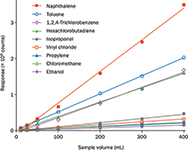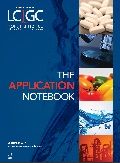Innovative Cryogen-Free Ambient Air Monitoring in Compliance with US EPA Method TO-15
The Application Notebook
This study demonstrates the excellent performance of Markes International's CIA Advantage–Kori–UNITY-xr pre-concentration system for confident GC–MS canister analysis of "air toxics" in humid environments, in accordance with US EPA Method TO-15.
US EPA Method TO-15 involves sampling of ambient air using canisters followed by thermal desorption pre-concentration, and GC–MS or GC–FID analysis. It is widely used by commercial laboratories for analysis of volatile organic compounds (VOCs) in urban and industrial settings, especially in the USA and Asia. However, traditional canister pre-concentration technologies are challenged by the ever-greater range of analytes and concentrations of interest, and by the range of temperatures and humidities at sampling locations. This study describes the performance of a new analytical system able to handle samples at high humidities, while remaining compliant with Method TO-15.
Experimental
The analytical system used was a CIA Advantage-xr canister auto-sampler with a Kori-xr™ water condenser and UNITY-xr™ thermal desorber, coupled to a GC–MS system. The entire system uses electrical trap cooling, eliminating the cost and inconvenience associated with liquid cryogen. Full analytical conditions are available in Markes
International's Application Note 081 (http://chem.markes.com/TO15).

Results and discussion
Chromatography: Figure 1 shows a typical analysis of the 10 ppbv TO-15 standard at 100% relative humidity (RH), and Figure 2 shows extracted-ion chromatograms (EICs) for five components spanning the volatility range. Note the excellent peak shape, especially for lighter VOCs, and the high degree of similarity between the three humidity levels, indicating the effectiveness of the Kori-xr water-removal module.

Linearities: At all three humidity levels, excellent linearities with respect to sample volume and concentration were obtained-Figure 3 shows examples of the former for the 100% RH sample, for the set of nine compounds spanning the volatility range.

Method Detection Limits (MDLs): These were calculated on the basis of seven replicate samples at 0.1 ppbv. To comply with Method TO-15, MDLs are required to be ≤0.5 ppbv. Our calculations gave a mean MDL of 14 pptv, with values for 54 out of the 65 compounds being at 20 pptv or below. Values ranged from 4 pptv for dichlorotetrafluoroethane, tetrahydrofuran, 1,1,1-trichloroethane and 1,2,4-trichlorobenzene to 45 pptv for ethanol, with a solitary "outlier" at 95 pptv for propene. These values are all very much lower than the requirement of ≤0.5 ppbv.
Relative Response Factors (RRFs): Method TO-15 requires that the calculated RSDs for the RRFs for each compound in the calibration table must be less than 30%, with at most two exceptions up to a limit of 40%. Results were well within the requirements of Method TO-15, with values at the 50%, 75%, and 100% RH levels being 7.9%, 9.0%, and 8.5% respectively.
Conclusions
In summary, the CIA Advantage–Kori–UNITY-xr pre-concentration system described allows confident GC–MS canister analysis of "air toxics" in humid environments, in accordance with US EPA Method TO-15. Key features of the results are the excellent chromatographic performance for the analysis of a 65-component TO-15 mix (from propene to naphthalene), at 50%, 75%, and 100% relative humidity. Performance was well within the requirements of Method TO-15, with method detection limits as low as 4 pptv.
Crucially, this performance has been achieved for even the most volatile of components in the TO-15 mix, due to the ability of the Kori-xr module to efficiently and selectively remove water from humid air streams, without compromising the analysis of very volatile organic compounds or polar species.
For the complete study, including a full table of results, download Markes International's Application Note 081
(http://chem.markes.com/TO15).

Markes International
Gwaun Elai Medi-Science Campus, Llantrisant, Wales, UK
tel. +44 (0)1443 230935, enquiries@markes.com
Website: www.markes.com

Separation of Ultra-Short and Long Chain PFAS Compounds Using a Positive Charge Surface Column
December 11th 2024A separation of ultra-short and long chain PFAS (C1-C18) is performed on a HALO®PCS Phenyl-Hexyl column along with a HALO®PFAS Delay column which demonstrates excellent retention for both hydrophilic and hydrophobic analytes.

.png&w=3840&q=75)

.png&w=3840&q=75)



.png&w=3840&q=75)



.png&w=3840&q=75)














